Marketing Plan for Sainsbury's: Situational Analysis and Sponsorship
VerifiedAdded on 2023/01/19
|10
|2695
|70
Report
AI Summary
This report presents a comprehensive marketing plan for Sainsbury's, a major retail organization. It begins with an introduction to marketing and its significance, followed by a detailed situational analysis that examines the marketing mix (7Ps) of Sainsbury's and a comparison with Walmart. The report then outlines a strategic marketing plan, including SMART objectives, a SWOT analysis, and strategies based on STP (Segmentation, Targeting, and Positioning). The action plan, based on the 4Ps of the marketing mix, details how Sainsbury's will promote its products through web series sponsorships. A marketing budget and monitoring/control mechanisms are also included, concluding with the importance of marketing in organizational success. The core focus is on using web series sponsorships to attract a younger demographic and increase sales.

Essentials
Paraphrase This Document
Need a fresh take? Get an instant paraphrase of this document with our AI Paraphraser
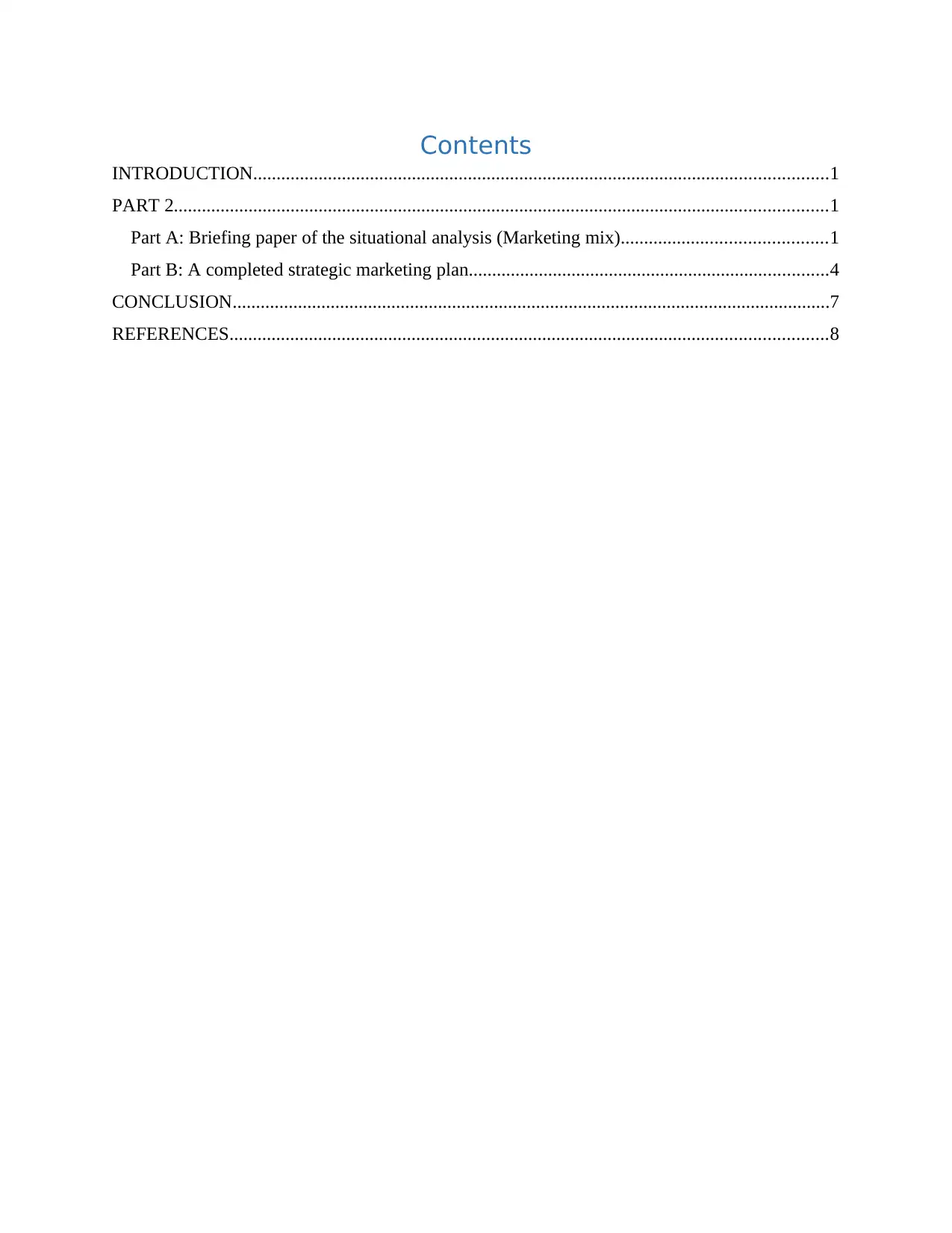
Contents
INTRODUCTION...........................................................................................................................1
PART 2............................................................................................................................................1
Part A: Briefing paper of the situational analysis (Marketing mix)............................................1
Part B: A completed strategic marketing plan.............................................................................4
CONCLUSION................................................................................................................................7
REFERENCES................................................................................................................................8
INTRODUCTION...........................................................................................................................1
PART 2............................................................................................................................................1
Part A: Briefing paper of the situational analysis (Marketing mix)............................................1
Part B: A completed strategic marketing plan.............................................................................4
CONCLUSION................................................................................................................................7
REFERENCES................................................................................................................................8
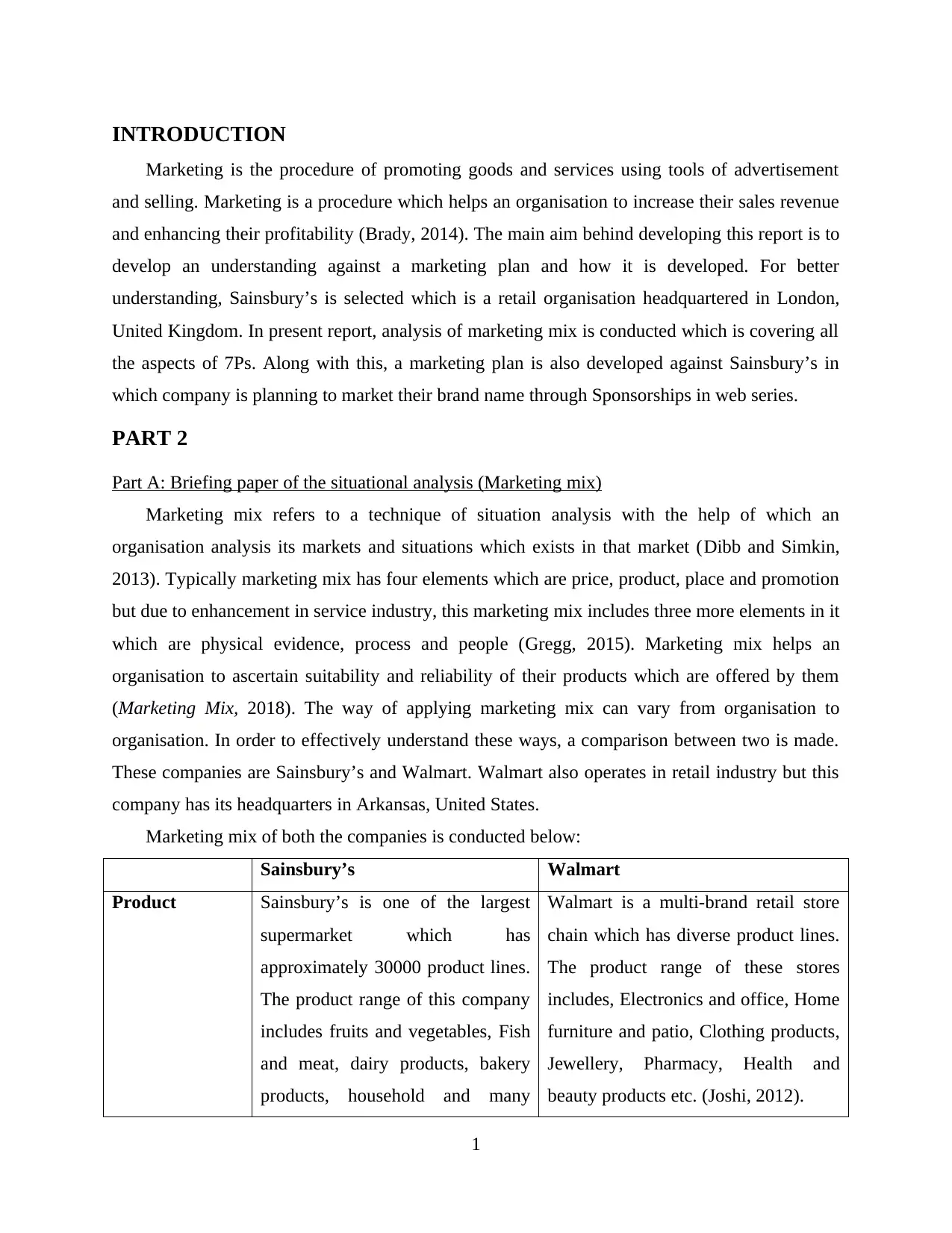
INTRODUCTION
Marketing is the procedure of promoting goods and services using tools of advertisement
and selling. Marketing is a procedure which helps an organisation to increase their sales revenue
and enhancing their profitability (Brady, 2014). The main aim behind developing this report is to
develop an understanding against a marketing plan and how it is developed. For better
understanding, Sainsbury’s is selected which is a retail organisation headquartered in London,
United Kingdom. In present report, analysis of marketing mix is conducted which is covering all
the aspects of 7Ps. Along with this, a marketing plan is also developed against Sainsbury’s in
which company is planning to market their brand name through Sponsorships in web series.
PART 2
Part A: Briefing paper of the situational analysis (Marketing mix)
Marketing mix refers to a technique of situation analysis with the help of which an
organisation analysis its markets and situations which exists in that market (Dibb and Simkin,
2013). Typically marketing mix has four elements which are price, product, place and promotion
but due to enhancement in service industry, this marketing mix includes three more elements in it
which are physical evidence, process and people (Gregg, 2015). Marketing mix helps an
organisation to ascertain suitability and reliability of their products which are offered by them
(Marketing Mix, 2018). The way of applying marketing mix can vary from organisation to
organisation. In order to effectively understand these ways, a comparison between two is made.
These companies are Sainsbury’s and Walmart. Walmart also operates in retail industry but this
company has its headquarters in Arkansas, United States.
Marketing mix of both the companies is conducted below:
Sainsbury’s Walmart
Product Sainsbury’s is one of the largest
supermarket which has
approximately 30000 product lines.
The product range of this company
includes fruits and vegetables, Fish
and meat, dairy products, bakery
products, household and many
Walmart is a multi-brand retail store
chain which has diverse product lines.
The product range of these stores
includes, Electronics and office, Home
furniture and patio, Clothing products,
Jewellery, Pharmacy, Health and
beauty products etc. (Joshi, 2012).
1
Marketing is the procedure of promoting goods and services using tools of advertisement
and selling. Marketing is a procedure which helps an organisation to increase their sales revenue
and enhancing their profitability (Brady, 2014). The main aim behind developing this report is to
develop an understanding against a marketing plan and how it is developed. For better
understanding, Sainsbury’s is selected which is a retail organisation headquartered in London,
United Kingdom. In present report, analysis of marketing mix is conducted which is covering all
the aspects of 7Ps. Along with this, a marketing plan is also developed against Sainsbury’s in
which company is planning to market their brand name through Sponsorships in web series.
PART 2
Part A: Briefing paper of the situational analysis (Marketing mix)
Marketing mix refers to a technique of situation analysis with the help of which an
organisation analysis its markets and situations which exists in that market (Dibb and Simkin,
2013). Typically marketing mix has four elements which are price, product, place and promotion
but due to enhancement in service industry, this marketing mix includes three more elements in it
which are physical evidence, process and people (Gregg, 2015). Marketing mix helps an
organisation to ascertain suitability and reliability of their products which are offered by them
(Marketing Mix, 2018). The way of applying marketing mix can vary from organisation to
organisation. In order to effectively understand these ways, a comparison between two is made.
These companies are Sainsbury’s and Walmart. Walmart also operates in retail industry but this
company has its headquarters in Arkansas, United States.
Marketing mix of both the companies is conducted below:
Sainsbury’s Walmart
Product Sainsbury’s is one of the largest
supermarket which has
approximately 30000 product lines.
The product range of this company
includes fruits and vegetables, Fish
and meat, dairy products, bakery
products, household and many
Walmart is a multi-brand retail store
chain which has diverse product lines.
The product range of these stores
includes, Electronics and office, Home
furniture and patio, Clothing products,
Jewellery, Pharmacy, Health and
beauty products etc. (Joshi, 2012).
1
⊘ This is a preview!⊘
Do you want full access?
Subscribe today to unlock all pages.

Trusted by 1+ million students worldwide
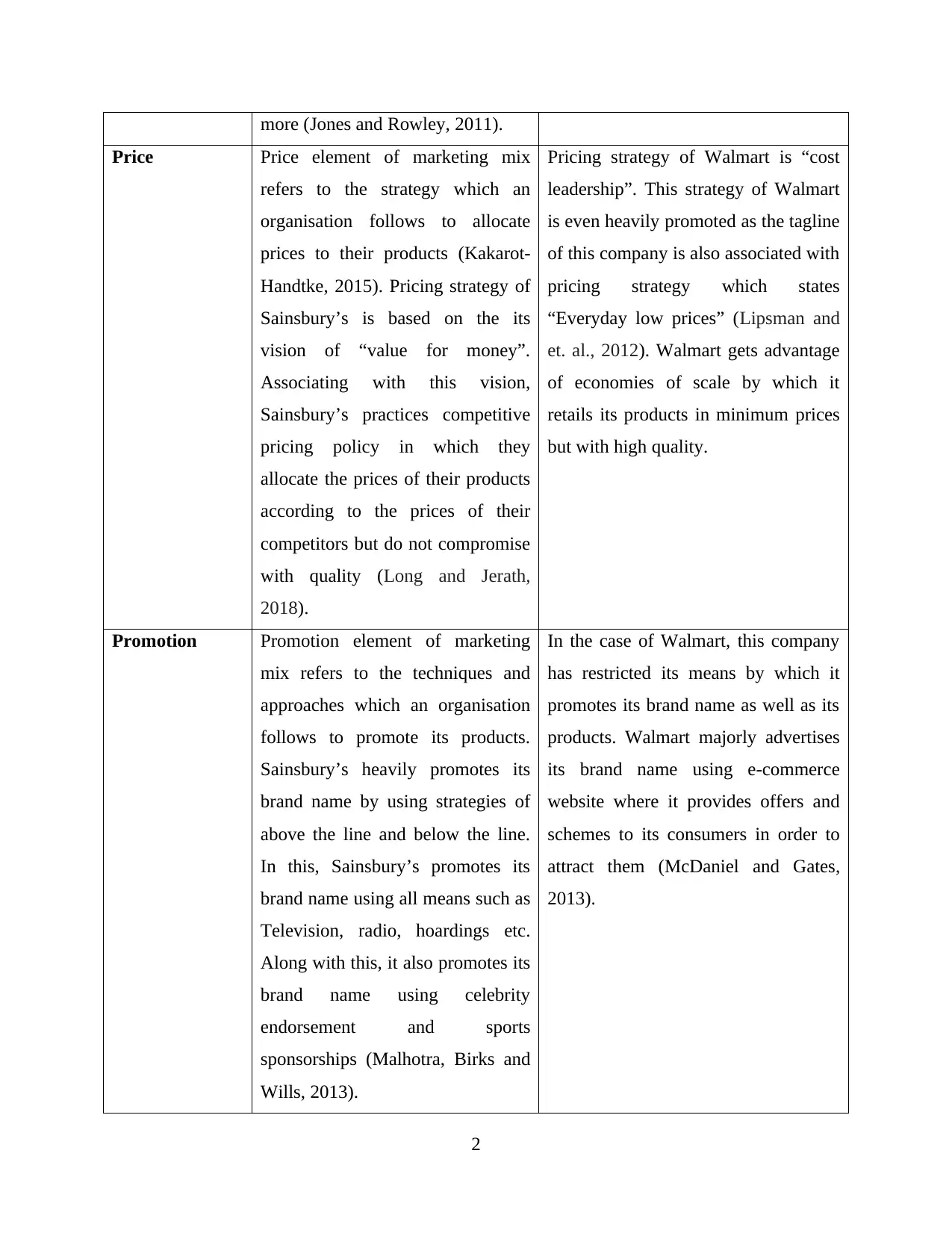
more (Jones and Rowley, 2011).
Price Price element of marketing mix
refers to the strategy which an
organisation follows to allocate
prices to their products (Kakarot-
Handtke, 2015). Pricing strategy of
Sainsbury’s is based on the its
vision of “value for money”.
Associating with this vision,
Sainsbury’s practices competitive
pricing policy in which they
allocate the prices of their products
according to the prices of their
competitors but do not compromise
with quality (Long and Jerath,
2018).
Pricing strategy of Walmart is “cost
leadership”. This strategy of Walmart
is even heavily promoted as the tagline
of this company is also associated with
pricing strategy which states
“Everyday low prices” (Lipsman and
et. al., 2012). Walmart gets advantage
of economies of scale by which it
retails its products in minimum prices
but with high quality.
Promotion Promotion element of marketing
mix refers to the techniques and
approaches which an organisation
follows to promote its products.
Sainsbury’s heavily promotes its
brand name by using strategies of
above the line and below the line.
In this, Sainsbury’s promotes its
brand name using all means such as
Television, radio, hoardings etc.
Along with this, it also promotes its
brand name using celebrity
endorsement and sports
sponsorships (Malhotra, Birks and
Wills, 2013).
In the case of Walmart, this company
has restricted its means by which it
promotes its brand name as well as its
products. Walmart majorly advertises
its brand name using e-commerce
website where it provides offers and
schemes to its consumers in order to
attract them (McDaniel and Gates,
2013).
2
Price Price element of marketing mix
refers to the strategy which an
organisation follows to allocate
prices to their products (Kakarot-
Handtke, 2015). Pricing strategy of
Sainsbury’s is based on the its
vision of “value for money”.
Associating with this vision,
Sainsbury’s practices competitive
pricing policy in which they
allocate the prices of their products
according to the prices of their
competitors but do not compromise
with quality (Long and Jerath,
2018).
Pricing strategy of Walmart is “cost
leadership”. This strategy of Walmart
is even heavily promoted as the tagline
of this company is also associated with
pricing strategy which states
“Everyday low prices” (Lipsman and
et. al., 2012). Walmart gets advantage
of economies of scale by which it
retails its products in minimum prices
but with high quality.
Promotion Promotion element of marketing
mix refers to the techniques and
approaches which an organisation
follows to promote its products.
Sainsbury’s heavily promotes its
brand name by using strategies of
above the line and below the line.
In this, Sainsbury’s promotes its
brand name using all means such as
Television, radio, hoardings etc.
Along with this, it also promotes its
brand name using celebrity
endorsement and sports
sponsorships (Malhotra, Birks and
Wills, 2013).
In the case of Walmart, this company
has restricted its means by which it
promotes its brand name as well as its
products. Walmart majorly advertises
its brand name using e-commerce
website where it provides offers and
schemes to its consumers in order to
attract them (McDaniel and Gates,
2013).
2
Paraphrase This Document
Need a fresh take? Get an instant paraphrase of this document with our AI Paraphraser
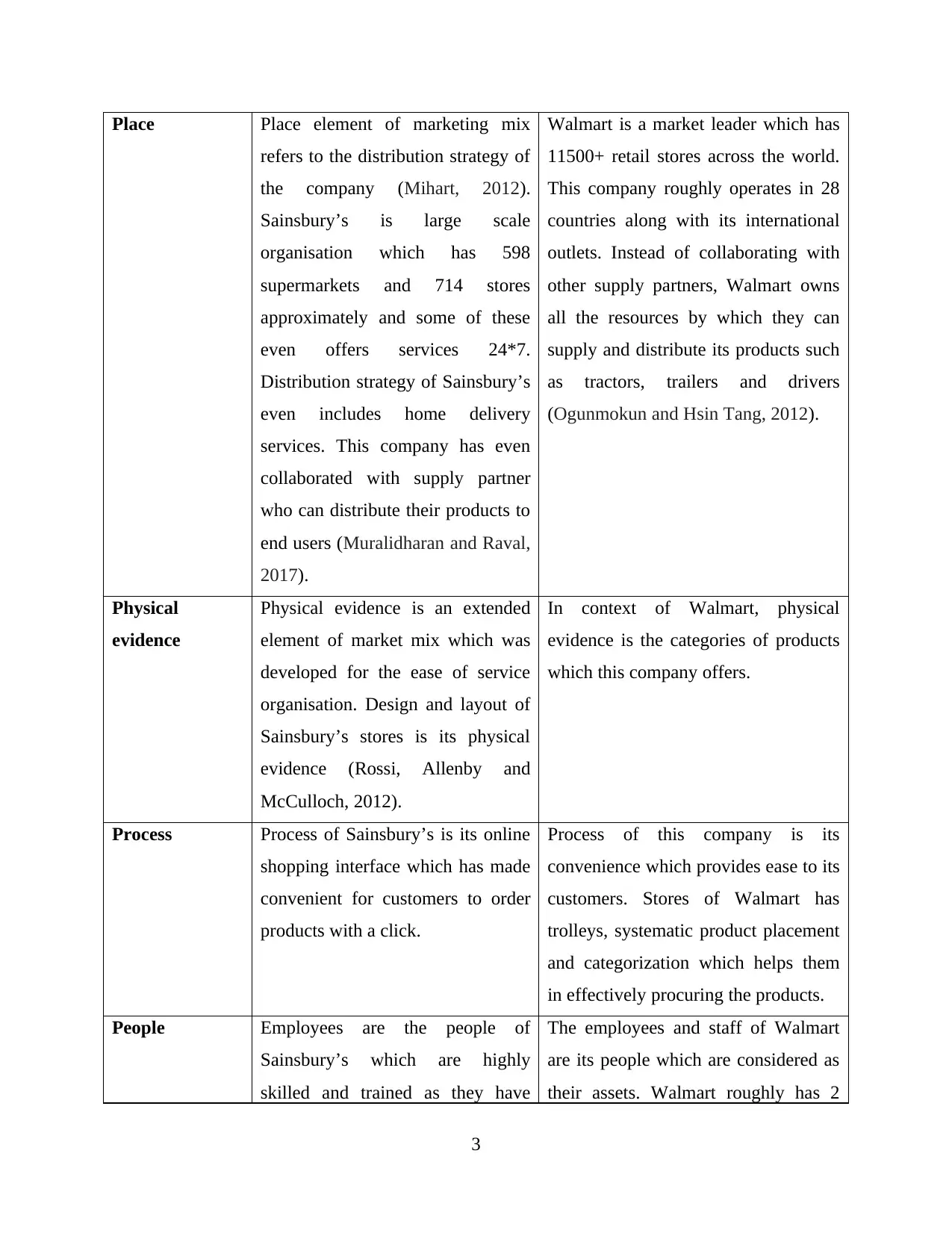
Place Place element of marketing mix
refers to the distribution strategy of
the company (Mihart, 2012).
Sainsbury’s is large scale
organisation which has 598
supermarkets and 714 stores
approximately and some of these
even offers services 24*7.
Distribution strategy of Sainsbury’s
even includes home delivery
services. This company has even
collaborated with supply partner
who can distribute their products to
end users (Muralidharan and Raval,
2017).
Walmart is a market leader which has
11500+ retail stores across the world.
This company roughly operates in 28
countries along with its international
outlets. Instead of collaborating with
other supply partners, Walmart owns
all the resources by which they can
supply and distribute its products such
as tractors, trailers and drivers
(Ogunmokun and Hsin Tang, 2012).
Physical
evidence
Physical evidence is an extended
element of market mix which was
developed for the ease of service
organisation. Design and layout of
Sainsbury’s stores is its physical
evidence (Rossi, Allenby and
McCulloch, 2012).
In context of Walmart, physical
evidence is the categories of products
which this company offers.
Process Process of Sainsbury’s is its online
shopping interface which has made
convenient for customers to order
products with a click.
Process of this company is its
convenience which provides ease to its
customers. Stores of Walmart has
trolleys, systematic product placement
and categorization which helps them
in effectively procuring the products.
People Employees are the people of
Sainsbury’s which are highly
skilled and trained as they have
The employees and staff of Walmart
are its people which are considered as
their assets. Walmart roughly has 2
3
refers to the distribution strategy of
the company (Mihart, 2012).
Sainsbury’s is large scale
organisation which has 598
supermarkets and 714 stores
approximately and some of these
even offers services 24*7.
Distribution strategy of Sainsbury’s
even includes home delivery
services. This company has even
collaborated with supply partner
who can distribute their products to
end users (Muralidharan and Raval,
2017).
Walmart is a market leader which has
11500+ retail stores across the world.
This company roughly operates in 28
countries along with its international
outlets. Instead of collaborating with
other supply partners, Walmart owns
all the resources by which they can
supply and distribute its products such
as tractors, trailers and drivers
(Ogunmokun and Hsin Tang, 2012).
Physical
evidence
Physical evidence is an extended
element of market mix which was
developed for the ease of service
organisation. Design and layout of
Sainsbury’s stores is its physical
evidence (Rossi, Allenby and
McCulloch, 2012).
In context of Walmart, physical
evidence is the categories of products
which this company offers.
Process Process of Sainsbury’s is its online
shopping interface which has made
convenient for customers to order
products with a click.
Process of this company is its
convenience which provides ease to its
customers. Stores of Walmart has
trolleys, systematic product placement
and categorization which helps them
in effectively procuring the products.
People Employees are the people of
Sainsbury’s which are highly
skilled and trained as they have
The employees and staff of Walmart
are its people which are considered as
their assets. Walmart roughly has 2
3
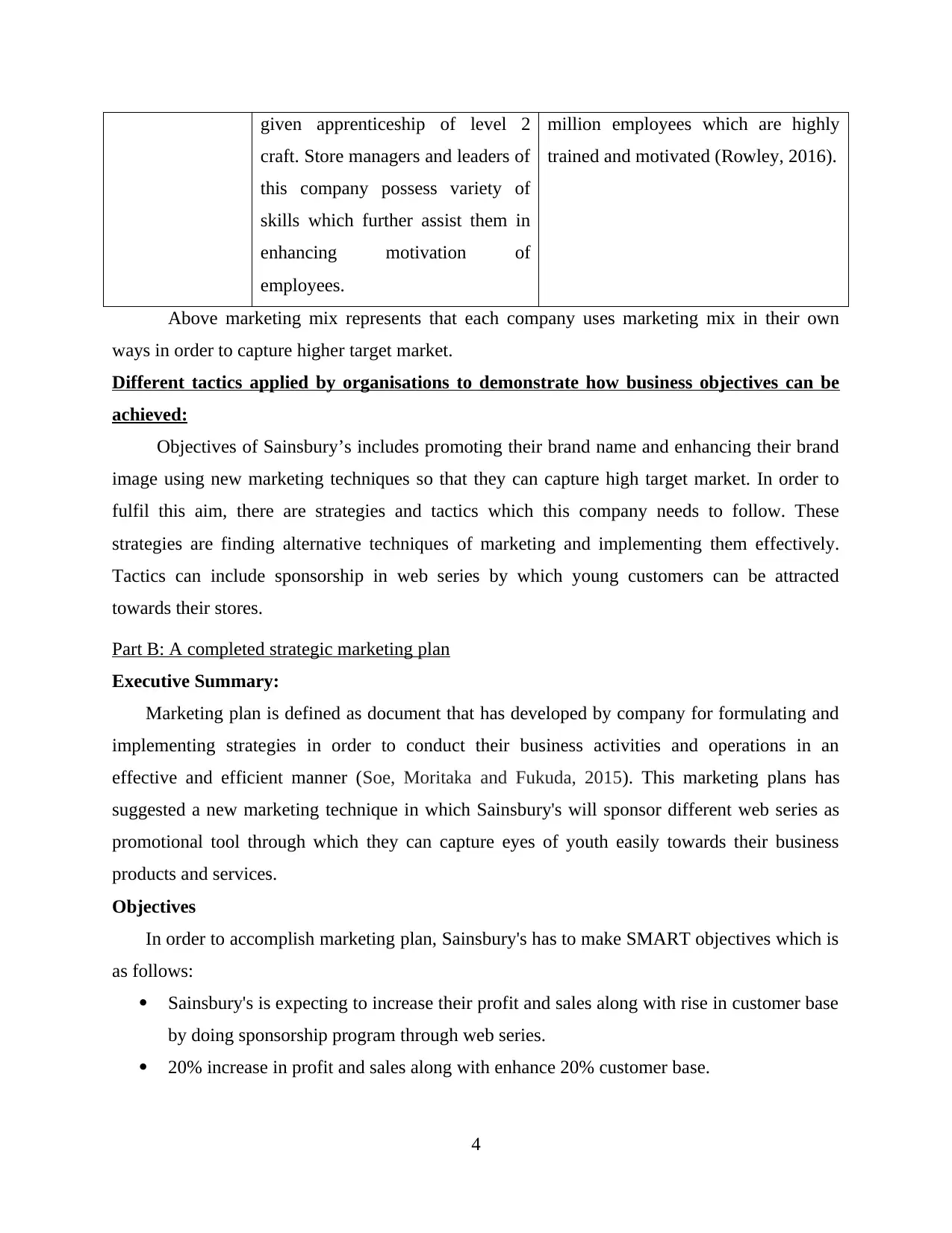
given apprenticeship of level 2
craft. Store managers and leaders of
this company possess variety of
skills which further assist them in
enhancing motivation of
employees.
million employees which are highly
trained and motivated (Rowley, 2016).
Above marketing mix represents that each company uses marketing mix in their own
ways in order to capture higher target market.
Different tactics applied by organisations to demonstrate how business objectives can be
achieved:
Objectives of Sainsbury’s includes promoting their brand name and enhancing their brand
image using new marketing techniques so that they can capture high target market. In order to
fulfil this aim, there are strategies and tactics which this company needs to follow. These
strategies are finding alternative techniques of marketing and implementing them effectively.
Tactics can include sponsorship in web series by which young customers can be attracted
towards their stores.
Part B: A completed strategic marketing plan
Executive Summary:
Marketing plan is defined as document that has developed by company for formulating and
implementing strategies in order to conduct their business activities and operations in an
effective and efficient manner (Soe, Moritaka and Fukuda, 2015). This marketing plans has
suggested a new marketing technique in which Sainsbury's will sponsor different web series as
promotional tool through which they can capture eyes of youth easily towards their business
products and services.
Objectives
In order to accomplish marketing plan, Sainsbury's has to make SMART objectives which is
as follows:
Sainsbury's is expecting to increase their profit and sales along with rise in customer base
by doing sponsorship program through web series.
20% increase in profit and sales along with enhance 20% customer base.
4
craft. Store managers and leaders of
this company possess variety of
skills which further assist them in
enhancing motivation of
employees.
million employees which are highly
trained and motivated (Rowley, 2016).
Above marketing mix represents that each company uses marketing mix in their own
ways in order to capture higher target market.
Different tactics applied by organisations to demonstrate how business objectives can be
achieved:
Objectives of Sainsbury’s includes promoting their brand name and enhancing their brand
image using new marketing techniques so that they can capture high target market. In order to
fulfil this aim, there are strategies and tactics which this company needs to follow. These
strategies are finding alternative techniques of marketing and implementing them effectively.
Tactics can include sponsorship in web series by which young customers can be attracted
towards their stores.
Part B: A completed strategic marketing plan
Executive Summary:
Marketing plan is defined as document that has developed by company for formulating and
implementing strategies in order to conduct their business activities and operations in an
effective and efficient manner (Soe, Moritaka and Fukuda, 2015). This marketing plans has
suggested a new marketing technique in which Sainsbury's will sponsor different web series as
promotional tool through which they can capture eyes of youth easily towards their business
products and services.
Objectives
In order to accomplish marketing plan, Sainsbury's has to make SMART objectives which is
as follows:
Sainsbury's is expecting to increase their profit and sales along with rise in customer base
by doing sponsorship program through web series.
20% increase in profit and sales along with enhance 20% customer base.
4
⊘ This is a preview!⊘
Do you want full access?
Subscribe today to unlock all pages.

Trusted by 1+ million students worldwide
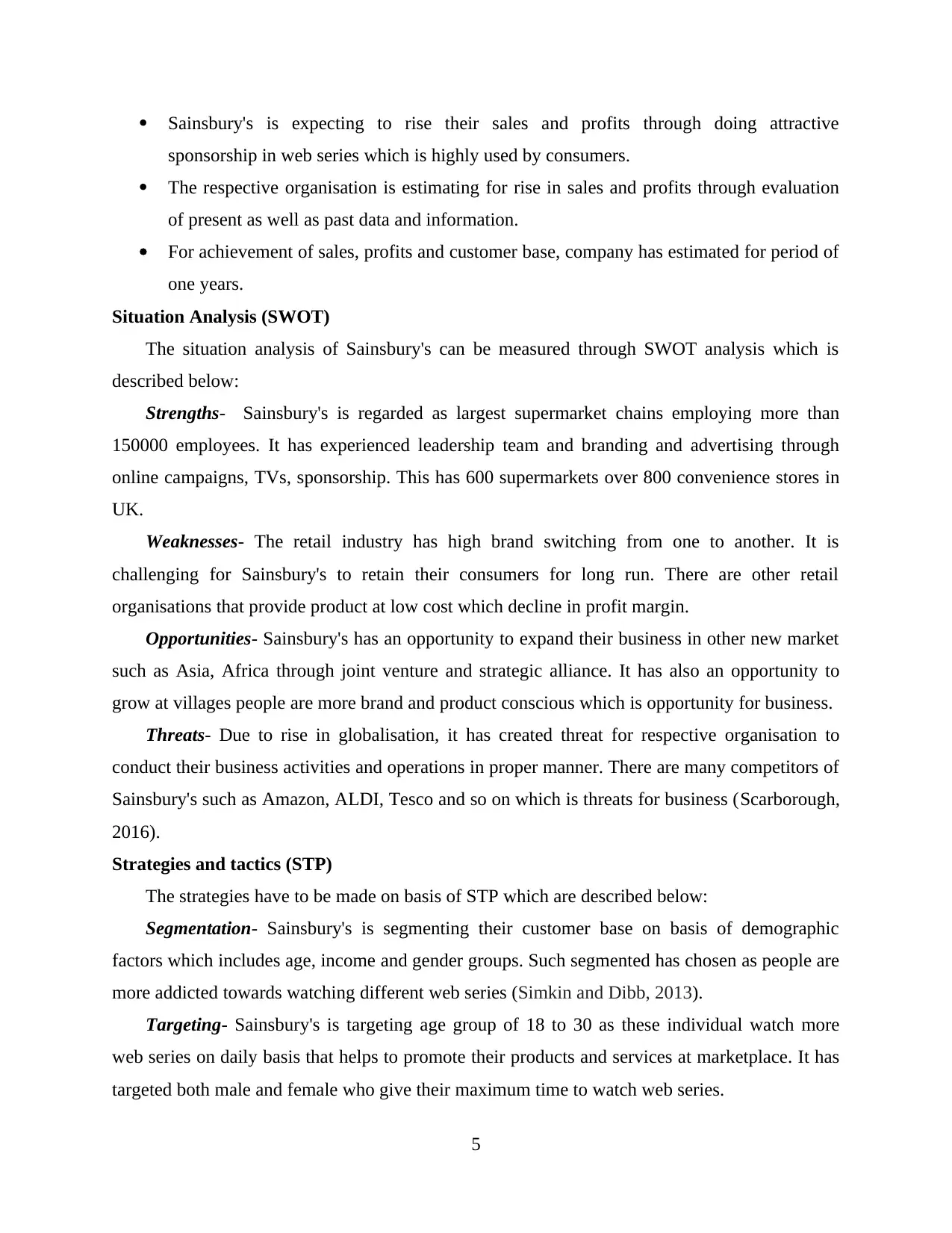
Sainsbury's is expecting to rise their sales and profits through doing attractive
sponsorship in web series which is highly used by consumers.
The respective organisation is estimating for rise in sales and profits through evaluation
of present as well as past data and information.
For achievement of sales, profits and customer base, company has estimated for period of
one years.
Situation Analysis (SWOT)
The situation analysis of Sainsbury's can be measured through SWOT analysis which is
described below:
Strengths- Sainsbury's is regarded as largest supermarket chains employing more than
150000 employees. It has experienced leadership team and branding and advertising through
online campaigns, TVs, sponsorship. This has 600 supermarkets over 800 convenience stores in
UK.
Weaknesses- The retail industry has high brand switching from one to another. It is
challenging for Sainsbury's to retain their consumers for long run. There are other retail
organisations that provide product at low cost which decline in profit margin.
Opportunities- Sainsbury's has an opportunity to expand their business in other new market
such as Asia, Africa through joint venture and strategic alliance. It has also an opportunity to
grow at villages people are more brand and product conscious which is opportunity for business.
Threats- Due to rise in globalisation, it has created threat for respective organisation to
conduct their business activities and operations in proper manner. There are many competitors of
Sainsbury's such as Amazon, ALDI, Tesco and so on which is threats for business (Scarborough,
2016).
Strategies and tactics (STP)
The strategies have to be made on basis of STP which are described below:
Segmentation- Sainsbury's is segmenting their customer base on basis of demographic
factors which includes age, income and gender groups. Such segmented has chosen as people are
more addicted towards watching different web series (Simkin and Dibb, 2013).
Targeting- Sainsbury's is targeting age group of 18 to 30 as these individual watch more
web series on daily basis that helps to promote their products and services at marketplace. It has
targeted both male and female who give their maximum time to watch web series.
5
sponsorship in web series which is highly used by consumers.
The respective organisation is estimating for rise in sales and profits through evaluation
of present as well as past data and information.
For achievement of sales, profits and customer base, company has estimated for period of
one years.
Situation Analysis (SWOT)
The situation analysis of Sainsbury's can be measured through SWOT analysis which is
described below:
Strengths- Sainsbury's is regarded as largest supermarket chains employing more than
150000 employees. It has experienced leadership team and branding and advertising through
online campaigns, TVs, sponsorship. This has 600 supermarkets over 800 convenience stores in
UK.
Weaknesses- The retail industry has high brand switching from one to another. It is
challenging for Sainsbury's to retain their consumers for long run. There are other retail
organisations that provide product at low cost which decline in profit margin.
Opportunities- Sainsbury's has an opportunity to expand their business in other new market
such as Asia, Africa through joint venture and strategic alliance. It has also an opportunity to
grow at villages people are more brand and product conscious which is opportunity for business.
Threats- Due to rise in globalisation, it has created threat for respective organisation to
conduct their business activities and operations in proper manner. There are many competitors of
Sainsbury's such as Amazon, ALDI, Tesco and so on which is threats for business (Scarborough,
2016).
Strategies and tactics (STP)
The strategies have to be made on basis of STP which are described below:
Segmentation- Sainsbury's is segmenting their customer base on basis of demographic
factors which includes age, income and gender groups. Such segmented has chosen as people are
more addicted towards watching different web series (Simkin and Dibb, 2013).
Targeting- Sainsbury's is targeting age group of 18 to 30 as these individual watch more
web series on daily basis that helps to promote their products and services at marketplace. It has
targeted both male and female who give their maximum time to watch web series.
5
Paraphrase This Document
Need a fresh take? Get an instant paraphrase of this document with our AI Paraphraser
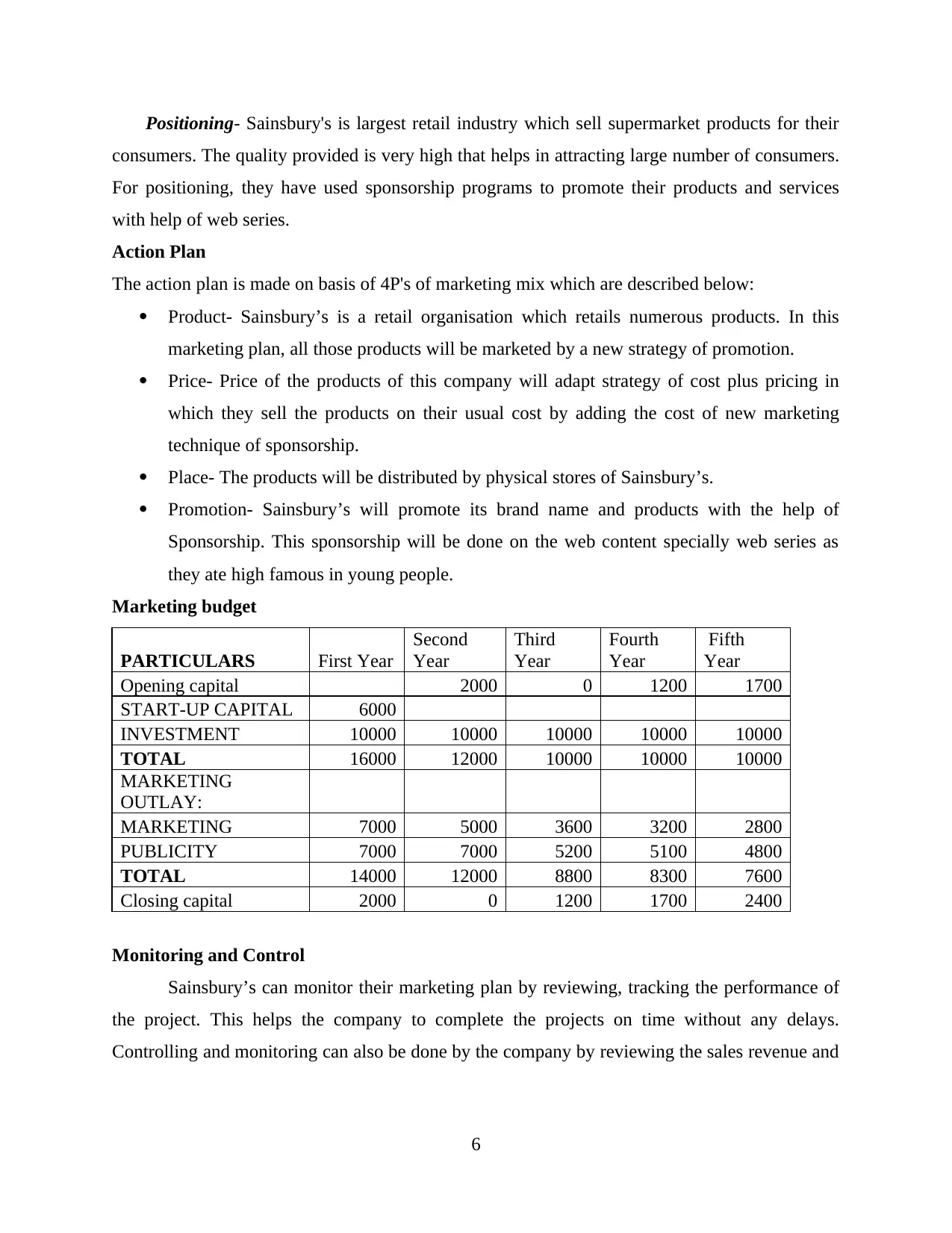
Positioning- Sainsbury's is largest retail industry which sell supermarket products for their
consumers. The quality provided is very high that helps in attracting large number of consumers.
For positioning, they have used sponsorship programs to promote their products and services
with help of web series.
Action Plan
The action plan is made on basis of 4P's of marketing mix which are described below:
Product- Sainsbury’s is a retail organisation which retails numerous products. In this
marketing plan, all those products will be marketed by a new strategy of promotion.
Price- Price of the products of this company will adapt strategy of cost plus pricing in
which they sell the products on their usual cost by adding the cost of new marketing
technique of sponsorship.
Place- The products will be distributed by physical stores of Sainsbury’s.
Promotion- Sainsbury’s will promote its brand name and products with the help of
Sponsorship. This sponsorship will be done on the web content specially web series as
they ate high famous in young people.
Marketing budget
PARTICULARS First Year
Second
Year
Third
Year
Fourth
Year
Fifth
Year
Opening capital 2000 0 1200 1700
START-UP CAPITAL 6000
INVESTMENT 10000 10000 10000 10000 10000
TOTAL 16000 12000 10000 10000 10000
MARKETING
OUTLAY:
MARKETING 7000 5000 3600 3200 2800
PUBLICITY 7000 7000 5200 5100 4800
TOTAL 14000 12000 8800 8300 7600
Closing capital 2000 0 1200 1700 2400
Monitoring and Control
Sainsbury’s can monitor their marketing plan by reviewing, tracking the performance of
the project. This helps the company to complete the projects on time without any delays.
Controlling and monitoring can also be done by the company by reviewing the sales revenue and
6
consumers. The quality provided is very high that helps in attracting large number of consumers.
For positioning, they have used sponsorship programs to promote their products and services
with help of web series.
Action Plan
The action plan is made on basis of 4P's of marketing mix which are described below:
Product- Sainsbury’s is a retail organisation which retails numerous products. In this
marketing plan, all those products will be marketed by a new strategy of promotion.
Price- Price of the products of this company will adapt strategy of cost plus pricing in
which they sell the products on their usual cost by adding the cost of new marketing
technique of sponsorship.
Place- The products will be distributed by physical stores of Sainsbury’s.
Promotion- Sainsbury’s will promote its brand name and products with the help of
Sponsorship. This sponsorship will be done on the web content specially web series as
they ate high famous in young people.
Marketing budget
PARTICULARS First Year
Second
Year
Third
Year
Fourth
Year
Fifth
Year
Opening capital 2000 0 1200 1700
START-UP CAPITAL 6000
INVESTMENT 10000 10000 10000 10000 10000
TOTAL 16000 12000 10000 10000 10000
MARKETING
OUTLAY:
MARKETING 7000 5000 3600 3200 2800
PUBLICITY 7000 7000 5200 5100 4800
TOTAL 14000 12000 8800 8300 7600
Closing capital 2000 0 1200 1700 2400
Monitoring and Control
Sainsbury’s can monitor their marketing plan by reviewing, tracking the performance of
the project. This helps the company to complete the projects on time without any delays.
Controlling and monitoring can also be done by the company by reviewing the sales revenue and
6
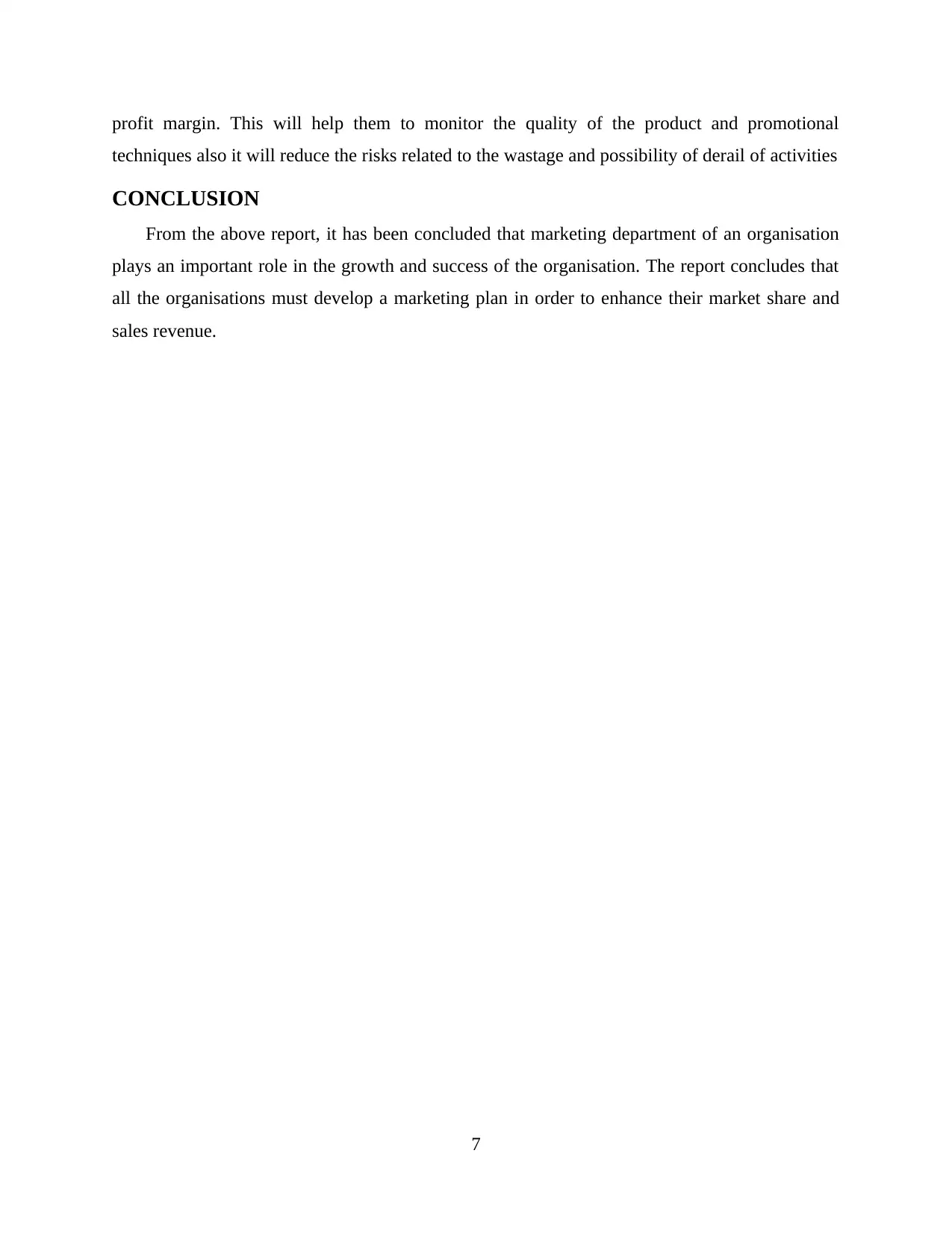
profit margin. This will help them to monitor the quality of the product and promotional
techniques also it will reduce the risks related to the wastage and possibility of derail of activities
CONCLUSION
From the above report, it has been concluded that marketing department of an organisation
plays an important role in the growth and success of the organisation. The report concludes that
all the organisations must develop a marketing plan in order to enhance their market share and
sales revenue.
7
techniques also it will reduce the risks related to the wastage and possibility of derail of activities
CONCLUSION
From the above report, it has been concluded that marketing department of an organisation
plays an important role in the growth and success of the organisation. The report concludes that
all the organisations must develop a marketing plan in order to enhance their market share and
sales revenue.
7
⊘ This is a preview!⊘
Do you want full access?
Subscribe today to unlock all pages.

Trusted by 1+ million students worldwide
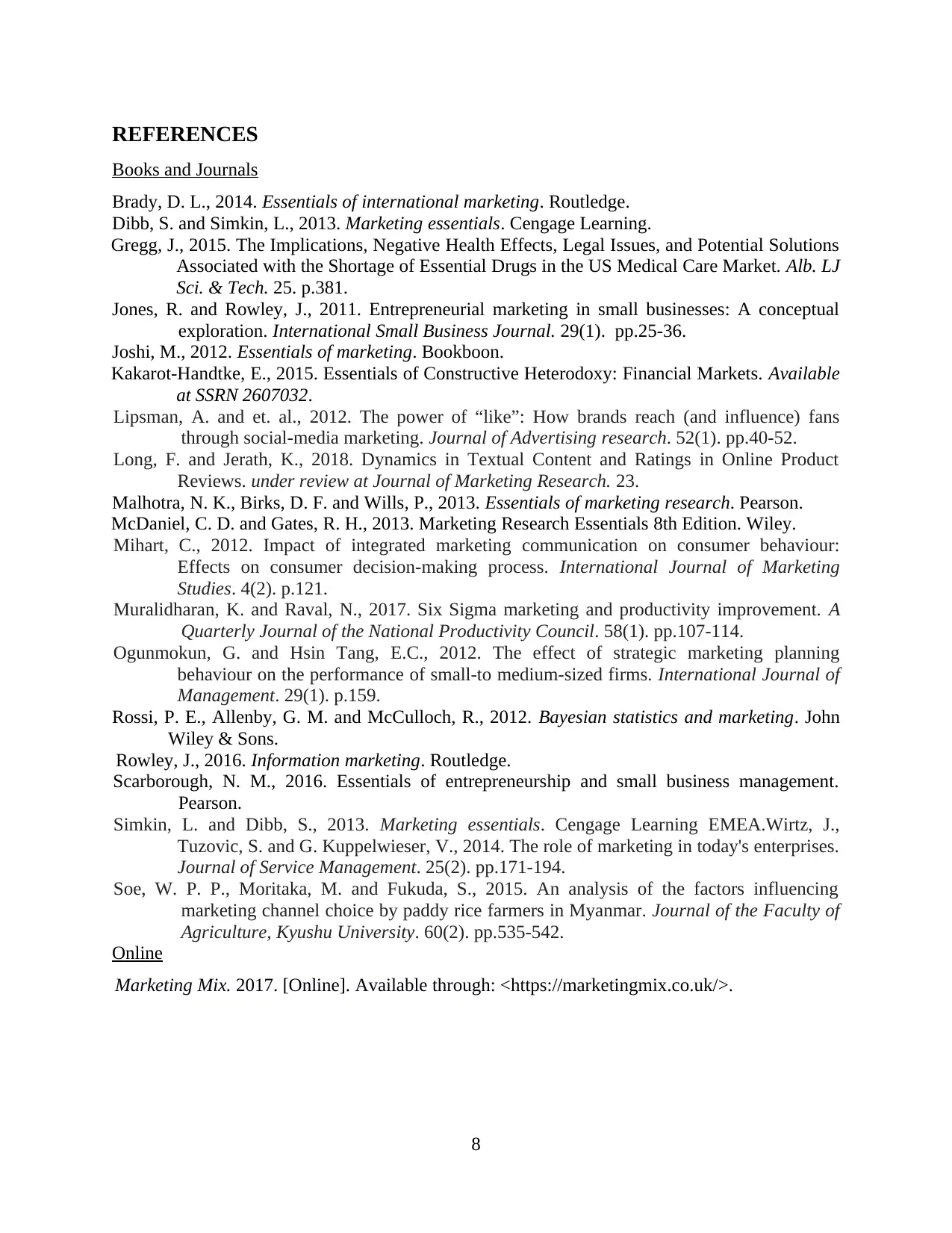
REFERENCES
Books and Journals
Brady, D. L., 2014. Essentials of international marketing. Routledge.
Dibb, S. and Simkin, L., 2013. Marketing essentials. Cengage Learning.
Gregg, J., 2015. The Implications, Negative Health Effects, Legal Issues, and Potential Solutions
Associated with the Shortage of Essential Drugs in the US Medical Care Market. Alb. LJ
Sci. & Tech. 25. p.381.
Jones, R. and Rowley, J., 2011. Entrepreneurial marketing in small businesses: A conceptual
exploration. International Small Business Journal. 29(1). pp.25-36.
Joshi, M., 2012. Essentials of marketing. Bookboon.
Kakarot-Handtke, E., 2015. Essentials of Constructive Heterodoxy: Financial Markets. Available
at SSRN 2607032.
Lipsman, A. and et. al., 2012. The power of “like”: How brands reach (and influence) fans
through social-media marketing. Journal of Advertising research. 52(1). pp.40-52.
Long, F. and Jerath, K., 2018. Dynamics in Textual Content and Ratings in Online Product
Reviews. under review at Journal of Marketing Research. 23.
Malhotra, N. K., Birks, D. F. and Wills, P., 2013. Essentials of marketing research. Pearson.
McDaniel, C. D. and Gates, R. H., 2013. Marketing Research Essentials 8th Edition. Wiley.
Mihart, C., 2012. Impact of integrated marketing communication on consumer behaviour:
Effects on consumer decision-making process. International Journal of Marketing
Studies. 4(2). p.121.
Muralidharan, K. and Raval, N., 2017. Six Sigma marketing and productivity improvement. A
Quarterly Journal of the National Productivity Council. 58(1). pp.107-114.
Ogunmokun, G. and Hsin Tang, E.C., 2012. The effect of strategic marketing planning
behaviour on the performance of small-to medium-sized firms. International Journal of
Management. 29(1). p.159.
Rossi, P. E., Allenby, G. M. and McCulloch, R., 2012. Bayesian statistics and marketing. John
Wiley & Sons.
Rowley, J., 2016. Information marketing. Routledge.
Scarborough, N. M., 2016. Essentials of entrepreneurship and small business management.
Pearson.
Simkin, L. and Dibb, S., 2013. Marketing essentials. Cengage Learning EMEA.Wirtz, J.,
Tuzovic, S. and G. Kuppelwieser, V., 2014. The role of marketing in today's enterprises.
Journal of Service Management. 25(2). pp.171-194.
Soe, W. P. P., Moritaka, M. and Fukuda, S., 2015. An analysis of the factors influencing
marketing channel choice by paddy rice farmers in Myanmar. Journal of the Faculty of
Agriculture, Kyushu University. 60(2). pp.535-542.
Online
Marketing Mix. 2017. [Online]. Available through: <https://marketingmix.co.uk/>.
8
Books and Journals
Brady, D. L., 2014. Essentials of international marketing. Routledge.
Dibb, S. and Simkin, L., 2013. Marketing essentials. Cengage Learning.
Gregg, J., 2015. The Implications, Negative Health Effects, Legal Issues, and Potential Solutions
Associated with the Shortage of Essential Drugs in the US Medical Care Market. Alb. LJ
Sci. & Tech. 25. p.381.
Jones, R. and Rowley, J., 2011. Entrepreneurial marketing in small businesses: A conceptual
exploration. International Small Business Journal. 29(1). pp.25-36.
Joshi, M., 2012. Essentials of marketing. Bookboon.
Kakarot-Handtke, E., 2015. Essentials of Constructive Heterodoxy: Financial Markets. Available
at SSRN 2607032.
Lipsman, A. and et. al., 2012. The power of “like”: How brands reach (and influence) fans
through social-media marketing. Journal of Advertising research. 52(1). pp.40-52.
Long, F. and Jerath, K., 2018. Dynamics in Textual Content and Ratings in Online Product
Reviews. under review at Journal of Marketing Research. 23.
Malhotra, N. K., Birks, D. F. and Wills, P., 2013. Essentials of marketing research. Pearson.
McDaniel, C. D. and Gates, R. H., 2013. Marketing Research Essentials 8th Edition. Wiley.
Mihart, C., 2012. Impact of integrated marketing communication on consumer behaviour:
Effects on consumer decision-making process. International Journal of Marketing
Studies. 4(2). p.121.
Muralidharan, K. and Raval, N., 2017. Six Sigma marketing and productivity improvement. A
Quarterly Journal of the National Productivity Council. 58(1). pp.107-114.
Ogunmokun, G. and Hsin Tang, E.C., 2012. The effect of strategic marketing planning
behaviour on the performance of small-to medium-sized firms. International Journal of
Management. 29(1). p.159.
Rossi, P. E., Allenby, G. M. and McCulloch, R., 2012. Bayesian statistics and marketing. John
Wiley & Sons.
Rowley, J., 2016. Information marketing. Routledge.
Scarborough, N. M., 2016. Essentials of entrepreneurship and small business management.
Pearson.
Simkin, L. and Dibb, S., 2013. Marketing essentials. Cengage Learning EMEA.Wirtz, J.,
Tuzovic, S. and G. Kuppelwieser, V., 2014. The role of marketing in today's enterprises.
Journal of Service Management. 25(2). pp.171-194.
Soe, W. P. P., Moritaka, M. and Fukuda, S., 2015. An analysis of the factors influencing
marketing channel choice by paddy rice farmers in Myanmar. Journal of the Faculty of
Agriculture, Kyushu University. 60(2). pp.535-542.
Online
Marketing Mix. 2017. [Online]. Available through: <https://marketingmix.co.uk/>.
8
1 out of 10
Related Documents
Your All-in-One AI-Powered Toolkit for Academic Success.
+13062052269
info@desklib.com
Available 24*7 on WhatsApp / Email
![[object Object]](/_next/static/media/star-bottom.7253800d.svg)
Unlock your academic potential
Copyright © 2020–2025 A2Z Services. All Rights Reserved. Developed and managed by ZUCOL.




